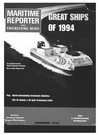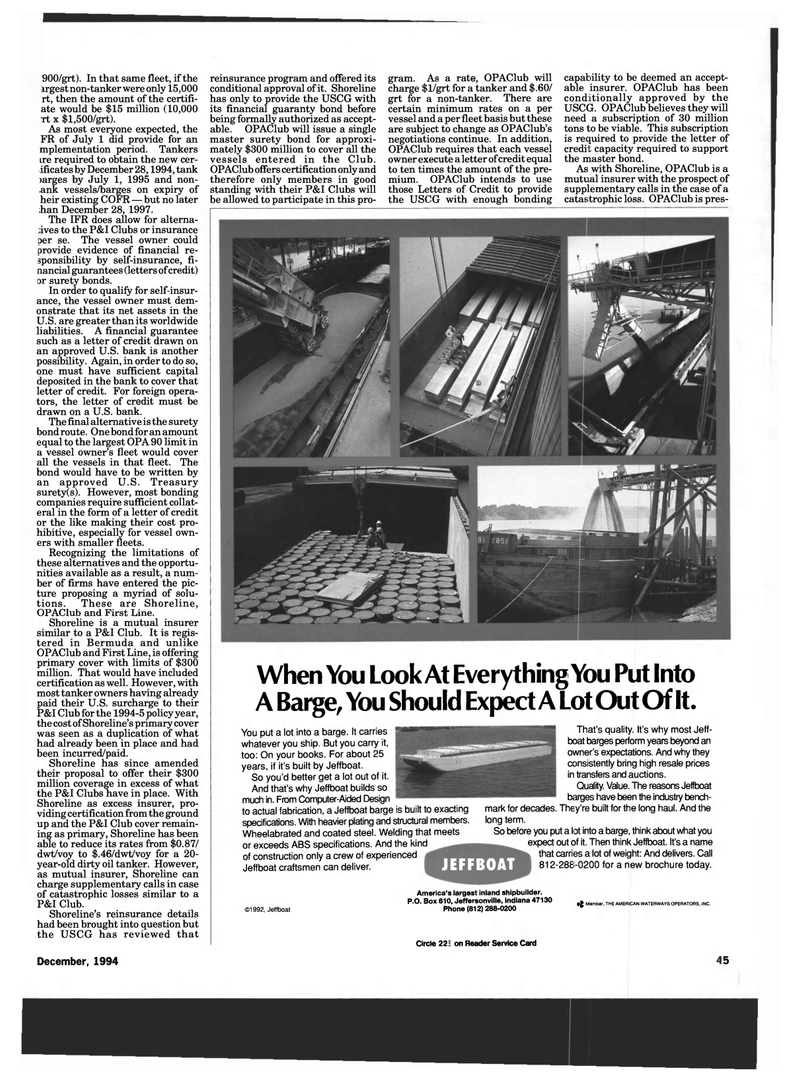
Page 45: of Maritime Reporter Magazine (December 1994)
Read this page in Pdf, Flash or Html5 edition of December 1994 Maritime Reporter Magazine
900/grt). In that same fleet, if the argest non-tanker were only 15,000 rt, then the amount of the certifi- ate would be $15 million (10,000 "rt x $l,500/grt).
As most everyone expected, the
FR of July 1 did provide for an mplementation period. Tankers ire required to obtain the new cer- tificates by December 28, 1994, tank jarges by July 1, 1995 and non- ,ank vessels/barges on expiry of heir existing COFR — but no later ;han December 28, 1997.
The IFR does allow for alterna- tes to the P&I Clubs or insurance per se. The vessel owner could provide evidence of financial re- sponsibility by self-insurance, fi- nancial guarantees (letters of credit) or surety bonds.
In order to qualify for self-insur- ance, the vessel owner must dem- onstrate that its net assets in the
U.S. are greater than its worldwide liabilities. A financial guarantee such as a letter of credit drawn on an approved U.S. bank is another possibility. Again, in order to do so, one must have sufficient capital deposited in the bank to cover that letter of credit. For foreign opera- tors, the letter of credit must be drawn on a U.S. bank.
The final alternative is the surety bond route. One bond for an amount equal to the largest OPA 90 limit in a vessel owner's fleet would cover all the vessels in that fleet. The bond would have to be written by an approved U.S. Treasury surety(s). However, most bonding companies require sufficient collat- eral in the form of a letter of credit or the like making their cost pro- hibitive, especially for vessel own- ers with smaller fleets.
Recognizing the limitations of these alternatives and the opportu- nities available as a result, a num- ber of firms have entered the pic- ture proposing a myriad of solu- tions. These are Shoreline,
OPAClub and First Line.
Shoreline is a mutual insurer similar to a P&I Club. It is regis- tered in Bermuda and unlike
OPAClub and First Line, is offering primary cover with limits of $300 million. That would have included certification as well. However, with most tanker owners having already paid their U.S. surcharge to their
P&I Club for the 1994-5 policy year, the cost of Shoreline's primary cover was seen as a duplication of what had already been in place and had been incurred/paid.
Shoreline has since amended their proposal to offer their $300 million coverage in excess of what the P&I Clubs have in place. With
Shoreline as excess insurer, pro- viding certification from the ground up and the P&I Club cover remain- ing as primary, Shoreline has been able to reduce its rates from $0.87/ dwt/voy to $.46/dwt/voy for a 20- year-old dirty oil tanker. However, as mutual insurer, Shoreline can charge supplementary calls in case of catastrophic losses similar to a
P&I Club.
Shoreline's reinsurance details had been brought into question but the USCG has reviewed that reinsurance program and offered its conditional approval of it. Shoreline has only to provide the USCG with its financial guaranty bond before being formally authorized as accept- able. OPAClub will issue a single master surety bond for approxi- mately $300 million to cover all the vessels entered in the Club.
OPAClub offers certification only and therefore only members in good standing with their P&I Clubs will be allowed to participate in this pro- gram. As a rate, OPAClub will charge $l/grt for a tanker and $.60/ grt for a non-tanker. There are certain minimum rates on a per vessel and a per fleet basis but these are subject to change as OPAClub's negotiations continue. In addition,
OPAClub requires that each vessel owner execute a letter of credit equal to ten times the amount of the pre- mium. OPAClub intends to use those Letters of Credit to provide the USCG with enough bonding capability to be deemed an accept- able insurer. OPAClub has been conditionally approved by the
USCG. OPAClub believes they will need a subscription of 30 million tons to be viable. This subscription is required to provide the letter of credit capacity required to support the master bond.
As with Shoreline, OPAClub is a mutual insurer with the prospect of supplementary calls in the case of a catastrophic loss. OPAClub is pres-
When You Look At Everything You Put Into
A Barge, You Should Expect A Lot Out Of It.
You put a lot into a barge. It carries whatever you ship. But you carry it, too: On your books. For about 25 years, if it's built by Jeffboat.
So you'd better get a lot out of it.
And that's why Jeffboat builds so much in. From Computer-Aided Design to actual fabrication, a Jeffboat barge is built to exacting specifications. With heavier plating and structural members.
Wheelabrated and coated steel. Welding that meets or exceeds ABS specifications. And the kind of construction only a crew of experienced
Jeffboat craftsmen can deliver. JEFFBOAT
That's quality. It's why most Jeff- boat barges perform years beyond an owner's expectations. And why they consistently bring high resale prices in transfers and auctions.
Quality. Value. The reasons Jeffboat barges have been the industry bench- mark for decades. They're built for the long haul. And the long term.
So before you put a lot into a barge, think about what you expect out of it. Then think Jeffboat. It's a name that carries a lot of weight: And delivers. Call 812-288-0200 for a new brochure today. ©1992, Jeffboat
America's largest inland shipbuilder.
P.O. Bo* 610, Jeffersonville, Indiana 47130
Phone (812) 288-0200 •2 Member. THE AMERICAN WATERWAYS OPERATORS, INC.
Circle 272 on Reader Service Card
December, 1994 51

 44
44

 46
46
